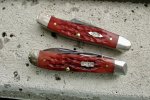wickettedge
Platinum Member
- Joined
- Mar 31, 2018
- Messages
- 2,603
I use this method and brand of dye thanks to
 Signalprick
Signalprick
Post in thread 'Case Tony Bose Collabs pic and discussion thread.'
https://www.bladeforums.com/threads...c-and-discussion-thread.1557814/post-21731106
Post in thread 'Case Tony Bose Collabs pic and discussion thread.'
https://www.bladeforums.com/threads...c-and-discussion-thread.1557814/post-21731106

















 I have to say I like it
I have to say I like it 